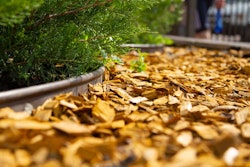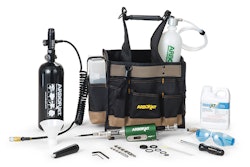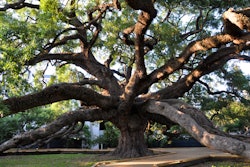Compared with the rest of the landscape, trees are about as low-maintenance as you can get, which makes them easy to overlook. Sure, you remember to water and fertilize them with the rest of the lawn, but they really need more than that to thrive. A regular maintenance program will add vigor and help prevent future problems.
Done properly, applying mulch around landscape ornamentals can be one of the best things you do for them. Mulching mistakes, by contrast, can stress and even kill plants. So it’s critical to familiarize yourself with mulching basics, as well as what kind of soil you’re working with.
The cover up
Overmulching is the most common mulching mistake perpetuated by a “monkey-see, monkey-do” mentality. In short, we’ve seen so many examples of mulch piled up high on tree trunks that we associate it with the correct way to mulch. This could not be further from the truth.
In fact, this is such a common problem that the International Society of Arboriculture has come up with a term to describe this improper method of mulching: mulch volcanoes. Its campaign against this technique implores landscapers to “mulch wide – not deep.” This epidemic of incorrect mulching has elevated to code-red status, becoming one of the leading causes of death of trees and shrubs.
Mulching too deep or too close to trees and plants can lead to plant injury and death in a number of ways:
Root suffocation. Roots need to breathe. Without acceptable levels of oxygen, roots begin to decline and will eventually die.
Dehydration. If you pile on the mulch too thick, you prohibit the penetration of water and dehydrate roots. In the case where water actually does make it through the mulch and to the soil, you then risk preventing natural evaporation, which will result in perpetually soggy soil and will eventually lead to root rot.
Fungus. Piling mulch against a tree trunk is an open invitation for fungi. The moist conditions provide the perfect environment for their growth and reproduction. Once the tree bark begins to decay, the fungi can easily enter the tree.
Insects. Research suggests some insects can instinctively detect a stressed tree or plant and will attack it preferentially. So not only will your ornamentals decline from the mulch, they will be less able to fend off insect pests.
Vertebrate pests. Thick mulch volcanoes provide a nice habitat for rodents who will feast on the inner bark of trees and cause girdling. The more extensive the chewing, the less likely you’ll be able to save the tree.
Excessive heat. You know that heat associated with composting? If your mulch is thick enough, that same process will occur. In fact, temperatures can reach 120 to 140 degrees Fahrenheit as decay occurs in the thick piles.
Unfortunately, you often won’t know if mulch is killing plants until it’s too late – sometimes the symptoms don’t show up for three to five years. You’ll probably first notice an overall decline of plant vigor and rate of growth, according to the Virginia Nursery & Landscaping Association. Symptoms can include:
· Off-color leaves (pale or marbled)
· Abnormally small leaves
· Poor twig growth
· Die-back of older branches
· Rotting, peeling trunk bark under the mulch
Mulching done right
To get the proper mix of mulch around trees and in landscape bedding, it’s imperative you consider the moisture needs of the plants, the type of soil you’re working with and the drainage characteristics. You’ll need to know these things before you select a mulch and determine the appropriate depth of the mulch.
For well-drained sites, you will typically apply a layer of mulch 2 to 4 inches deep. For soils that don’t drain well, you’ll want to keep mulch to no more than 2 inches deep. And for soils that perpetually retain water, you may have to forego mulch altogether, despite its benefits.
As you apply the mulch, remember to keep it away from tree trunks and other plants. For younger trees, your guideline should be no closer than 3 inches. For more mature trees, you’ll want to keep mulch even farther away, at a minimum distance of 8 inches. In ideal situations, you should extend the mulched area all the way to the tree’s dripline. This isn’t always possible as aesthetics often dictate a smaller mulched area, but it’s best for the health of the tree.
When selecting a type of mulch, you’ll choose from mulches in two categories. Inorganic mulches include stone, lava rock, pulverized rubber, geotextile fabrics and other materials that don’t easily decompose. Organic mulches, on the other hand, will decompose more readily and include wood chips, pine needles, leaves, cocoa hulls, softwood and hardwood bark, etc.
The benefit of inorganic mulches is that they don’t often need to be replaced; however, they do nothing to improve the soil structure, either. Organic mulches provide nutrients and improve soil quality and fertility.
The merits of mulching
In addition to making a landscape look more manicured, mulch applied correctly offers many benefits to plants. It works to improve soil conditions and helps soil maintain moisture by decreasing water loss. It also keeps weeds at bay and minimizes their competition for water and nutrients. It provides insulation for soil, keeping it warmer in the winter and cooler in the summer. It protects tree trunks and plants from string trimmer and mower damage, and it reduces soil compaction by diverting foot and vehicle traffic.










